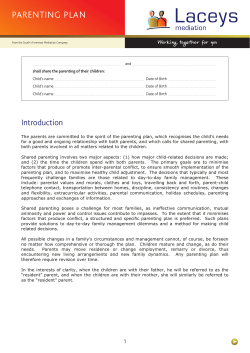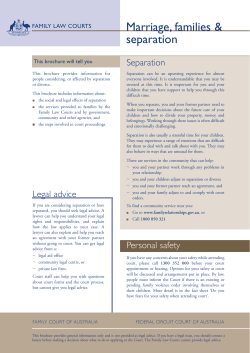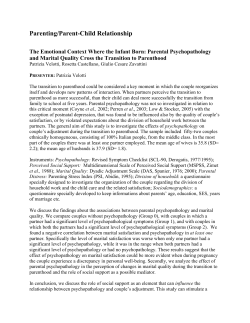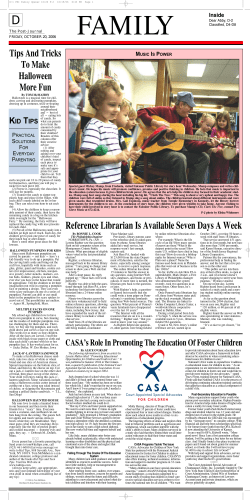
Services for Pregnant and Parenting Youth In or Exiting Substitute Care
Services for Pregnant and Parenting Youth In or Exiting Substitute Care Annotated Bibliography Introduction Teen pregnancy and parenting pose significant developmental challenges for youth; even more for youth who are in, or have recently exited, substitute care. The children of youth in substitute care may or may not be in the custody of the State—in either case, family-serving systems across the spectrum of prevention, early childhood intervention, in-home family preservation, out-of-home placement, and programs for runaway youth and unaccompanied minors support pregnant or parenting youth. A well-thought-out system of support helps current and former foster teen parents transition successfully to adulthood and supports them in their roles as parents, leading to positive outcomes for both the young parents and their children. The special needs of pregnant and parenting teens have generally not received much attention from the child welfare system. However, the Administration on Children, Youth and Families recently announced a discretionary funding opportunity for Improving Service Delivery to Youth in the Child Welfare System (HHS-2011-ACF-ACYF-CW-0186) Pregnant and parenting teens in or at risk of entering foster care are among the groups of youth to be served. What follows are resources to assist public and private agencies in designing and implementing services for pregnant and parenting youth in and exiting substitute care. In addition, the National Resource Center (NRC) for In-Home Services, along with the NRC for Youth Development and the FRIENDS NRC for Community-Based Child Abuse Prevention, will cosponsor a series of webinars on this topic beginning in late August, 2011. Information on the dates and times will be provided on the appropriate listserves and on the NRC websites: NRC for In-Home Services: www.nrcinhome.socialwork.uiowa.edu NRC for Youth Development: www.nrcyd.ou.edu FRIENDS NRC for Community-Based Child Abuse Prevention: www.friendsnrc.org For more information about these resources, to obtain a copy of a resource not available for download, or for technical assistance, please contact the NRC for In-Home Services by email at [email protected] or by telephone at 319.335.4932. 1 General Issues Related to Pregnant and Parenting Youth in Care These resources describe the prevalence, needs, and experiences of pregnant and parenting youth who are in and exiting substitute care. Pregnant and Parenting Teens in Foster Care in Fresno County, California: Who Are They and How Can We Help? (1,741 KB) First 5 Fresno County (2009) Explores issues relating to pregnant and parenting teens in foster care and their children in Fresno County, California. The paper is based on interviews with social workers, their supervisors and program managers, pregnant and parenting teens, nurses, educators, and others who work with these teens and their children. www.co.fresno.ca.us/uploadedFiles/Departments/Children_and_Family_Services/Child_Welfare /Pregnant%20and%20Parenting%20Foster%20Teens%20June2009.pdf Pregnant and Parenting Foster Youth: Their Needs, Their Experiences Chapin Hall at the University of Chicago (2009) Analyzes administrative data from the Teen Parenting Service Network (TPSN), a comprehensive service delivery system targeting pregnant and parenting foster youth in the Chicago metropolitan area, and links them to records from the Illinois Department of Children and Family Services, the Chicago public school system, and the Illinois Medicaid Paid Claims Longitudinal Database. To help contextualize the findings, interviews were also conducted with program directors and caseworkers at each of the five private child welfare agencies in the TPSN. http://chapinhall.org/research/report/pregnant-and-parenting-foster-youth-their-needs-theirexperiences Antecedents and Concomitants of Parenting Stress in Adolescent Mothers in Foster Care Budd, Holdsworth, & HoganBruen Child Abuse & Neglect, 30(5), 2006 Reports on a study that followed 49 adolescent mothers who were wards in Illinois foster care. The study examined whether parenting variables (childrearing beliefs, quality of parent-child interactions, and child abuse risk) and personal adjustment variables (emotional distress and social support) at initial assessment predicted parenting stress measured at follow-up. Results indicate that parenting variables, but not personal adjustment variables, predicted later parenting stress; educational status and social support predicted concurrent parenting stress, whereas number of childbirths did not. www.eric.ed.gov/ERICWebPortal/search/detailmini.jsp?_nfpb=true&_&ERICExtSearch_Search Value_0=EJ737515&ERICExtSearch_SearchType_0=no&accno=EJ737515 Fostering Hope: Preventing Teen Pregnancy Among Youth in Foster Care (795 KB) National Campaign to Prevent Teen Pregnancy & Uhlich Children's Advantage Network (2005) Provides quantitative research on the high rates of teen pregnancy among foster care youth, new qualitative research findings from Chicago-area focus groups in which foster care youth and foster parents were asked for their perspectives on teen pregnancy, and results of an online survey of Chicago-area child welfare service providers. www.thenationalcampaign.org/resources/pdf/pubs/FosteringHope_FINAL.pdf 2 Children Raising Children: City Fails to Adequately Assist Pregnant and Parenting Youth in Foster Care (107 KB) Public Advocate for the City of New York (2005) Explores gaps in services to New York City foster youth who are pregnant or who have young children, presents the results of a survey of foster care agencies, and provides recommendations for improving services to this population. www.nyc.gov/html/records/pdf/govpub/2708children_raising_children.pdf Populations Needing Special Attention Smith (2011) In Youth Leaving Foster Care: A Developmental, Relationship-Based Approach to Practice Focuses on providing services to three groups leaving foster care: youth with disabilities; lesbian, gay, bisexual, and transgender youth; and pregnant and parenting youth. It offers an overview of outcomes and issues for each group, a discussion of the effects of maltreatment, and interaction between the particular issue and development. Services and practice recommendations are described for each group. http://library.childwelfare.gov/cwig/ws/library/docs/gateway/ResultSet?w=NATIVE%28%27SIMP LE_SRCH+ph+is+%27%27Populations+Needing+Special+Attention%27%27%27%29&upp=0& rpp=25&order=native%28%27year%2FDescend%27%29&r=1 Assessing the Needs of Pregnant and Parenting Youth in Care These resources describe approaches to needs assessment for pregnant and parenting youth in substitute care. Antecedents and Concomitants of Parenting Stress in Adolescent Mothers in Foster Care Budd, Holdsworth, & HoganBruen Child Abuse & Neglect, 30(5), 2006 Reports on a study that followed 49 adolescent mothers who were wards in Illinois foster care. The study examined whether parenting variables (childrearing beliefs, quality of parent-child interactions, and child abuse risk) and personal adjustment variables (emotional distress and social support) at initial assessment predicted parenting stress measured at follow-up. Results indicate that parenting variables, but not personal adjustment variables, predicted later parenting stress; educational status and social support predicted concurrent parenting stress, whereas number of childbirths did not. www.eric.ed.gov/ERICWebPortal/search/detailmini.jsp?_nfpb=true&_&ERICExtSearch_Search Value_0=EJ737515&ERICExtSearch_SearchType_0=no&accno=EJ737515 Psychosocial Assessment of Teenage Parents: Lessons Learned in Its Application to Child Welfare Budd (2004) In Using Evidence in Social Work Practice: Behavioral Perspectives Describes a comprehensive approach for assessing the service needs of adolescent parents in foster care. The model was developed based on evidence in the empirical literature regarding risks and protective factors affecting teenage parents and on the practical experiences of social service workers who collaborated with the author in its design and application. This chapter discusses the rationale, method, and the potential benefits and challenges of implementing a 3 comprehensive assessment model tailored to adolescent parents in the child protection system. www.amazon.com/Using-Evidence-Social-Work-Practice/dp/0925065447 Programs and Services The following resources address specific needs of parenting teens in substitute care and their children: Comprehensive Services Framework Home Visiting/Prevention Parent Training Permanency Planning Health and Developmental Services for Young Parents Mental Health Services Housing Services • Maternity Group and Residential Placements • Supportive Housing Services Targeted for the Child Social Support Legal Status and Advocacy Comprehensive Services Framework Procedures 302: Services Delivered by the Department Illinois Department of Children and Family Services The Illinois DCFS provides a wide variety of specific services and placements to pregnant and parenting wards. These services are described in Illinois's DCFS Procedures 302, Appendix J. Illinois Teen Parenting Services Network (814 KB) The Illinois Teen Parenting Services Network (TPSN), a program of UCAN, provides comprehensive clinical services to youth who are in substitute care. www.ucanchicago.org/tpsn Home Visiting/Prevention Find Youth Info Provides information, strategies, tools, and resources for youth, families, schools, and community organizations on a variety of crosscutting topics that affect youth. The program directory features evidence-based programs, including teen parenthood and teen pregnancy prevention programs. www.findyouthinfo.gov 4 Supporting Evidence-Based Home Visiting to Prevent Child Maltreatment (EBHV) Grant Program Grantee Profile: Rhode Island KIDS COUNT Children's Bureau (2009) Describes the goals, participating organizations, and plans for the local evaluation of a NurseFamily Partnership program for low-income, first-time parents age 24 and under, and their families living in one of four urban communities with high rates of child maltreatment. www.supportingebhv.org/component/joomdoc/doc_download/59-rhode-island-profile Young Parents Program Children's Hospital Boston Provides information for parents and clinicians about a clinic dedicated to working with teen mothers and fathers from low-income and at-risk environments with the highest rates of pregnancies and the greatest risk of poor birth outcomes. www.childrenshospital.org/clinicalservices/Site2277/mainpageS2277P0.html Parent Training Directions for Intervention With Adolescent Mothers in Substitute Care Stockman & Budd Families in Society, 78(6), 1997 Presents the findings of a parent training survey conducted with service providers in 28 agencies across Illinois that serve teen mothers who are wards of the State. The parent-training methods identified by providers as most effective were informal modeling, didactic classes, home visiting, peer-support groups, and mentoring. Engagement strategies rated most effective with adolescent mothers were provision of food, transportation, and babysitting during sessions. http://library.childwelfare.gov/cwig/ws/library/docs/gateway/ResultSet?w=NATIVE%28%27SIMP LE_SRCH+ph+is+%27%27Directions+for+Intervention+With+Adolescent+Mothers%27%27%27 %29&upp=0&rpp=25&order=native%28%27year%2FDescend%27%29&r=1 Permanency Planning Achieving Permanency for Pregnant and Parenting Teens in Foster Care Klain ABA Child Law Practice, 23(10), 2004 Addresses issues and circumstances attorneys and judges should consider in making permanency planning decisions for pregnant and parenting teens. Guidelines are provided for preliminary inquiries, for dealing with a teen who becomes pregnant while in care, and for determining the permanency plan. Key considerations in permanency options are explored. http://apps.americanbar.org/child/clp/archives/vol23/dec04.pdf Health and Developmental Services Risking Their Future: Understanding the Health Behaviors of Foster Care Youth (3,328 KB) Schuyler Center for Analysis and Advocacy (2009) Describes two foster care maternity residence programs in New York: Inwood House Maternity 5 Residences and Family Support Programs, New York City; and Community Maternity Services, Albany. www.scaany.org/resources/documents/risking_their_future_report.pdf Nowhere to Turn: The Battle of Girls in Care to Exercise Their Reproductive Rights (956 KB) Pierce Michigan Child Welfare Law Journal, 12(1), 2008 Explores the following issues: What are the reproductive rights of youth in foster care? What are the barriers to accessing these services, and what creates these barriers? Finally, what responsibility does the State and other systems have to assure that these girls' reproductive rights are respected? http://chanceatchildhood.msu.edu/pdf/CWLJ_fa08.pdf Fostering Hope: Preventing Teen Pregnancy Among Youth in Foster Care (795 KB) National Campaign to Prevent Teen Pregnancy & Uhlich Children's Advantage Network (2005) Provides quantitative research on the high rates of teen pregnancy among foster care youth, new qualitative research findings from Chicago-area focus groups in which foster care youth and foster parents were asked for their perspectives on teen pregnancy, and results of an online survey of Chicago-area child welfare service providers. www.thenationalcampaign.org/resources/pdf/pubs/FosteringHope_FINAL.pdf Mental Health Services Illinois Teen Parenting Services Network Provides information about the Illinois Teen Parenting Services Network (TPSN), a program of UCAN, which provides comprehensive clinical services to youth who are wards of the State of Illinois. www.ucanchicago.org/tpsn Housing Services Maternity Group and Residential Placements The California Evidence-Based Clearinghouse for Child Welfare Presents child welfare professionals with information about selected evidence-based child welfare programs, including a list of specific programs focusing on pregnant and parenting youth as they transition to adulthood. www.cebc4cw.org/topic/youth-transitioning-into-adulthood The Implementation of Maternity Group Home Programs: Serving Pregnant and Parenting Teens in a Residential Setting, Final Report Office of the Assistant Secretary for Planning and Evaluation, U.S. Department of Health and Human Services (2005) Examines maternity group home programs in seven States. The report addresses the following for each program: management, funding, and target population; services provided; 6 and staffing and costs. http://aspe.hhs.gov/hsp/grouphomes04/imp05 http://aspe.hhs.gov/hsp/grouphomes04/imp05/report.pdf (938 KB) Summary Report: Promoting Successful Transition from Foster/Group Home Settings to Independent Living Among Pregnant and Parenting Teens (139 KB) Healthy Teen Network (2005) Presents the findings of a study that investigated essential components for promoting successful transitions to independent living among pregnant and parenting teens. Findings indicate pregnant and parenting teens in foster care/alternative settings do best when they have insight and program buy-in, have consistent family (or other trusted adult) support, have healthy relationships with both peers and significant others, and have comprehensive support services available to them. Barriers to successful outcomes are identified, as well as individual, program, and policy needs for promoting successful transition. www.healthyteennetwork.org/vertical/Sites/%7BB4D0CC76-CF78-4784-BA7C5D0436F6040C%7D/uploads/%7B88D99A07-ADB4-4164-AAEA-E450030A1746%7D.PDF Individual and Group-Based Parenting Programmes for Improving Psychosocial Outcomes for Teenage Parents and Their Children (126 KB) Coren & Barlow (2003) Suggests, from findings in England, that parenting programs may be effective in improving outcomes for both teenage mothers and their infants. There is, however, a need for further research into the effectiveness of parenting programs for teenage parents. http://web.archive.org/web/20070205051445/http://www.campbellcollaboration.org/docpdf/teenpar.pdf Supportive Housing Bricks, Mortar, and Community: The Foundations of Supportive Housing for Pregnant and Parenting Teens: Findings from the Field (1,034 KB) Healthy Teen Network & Child Trends (2010) Identifies a set of core components for supportive housing programs serving pregnant and parenting teens and presents case studies of programs meeting these standards. Core components of supportive housing among programs included supports and resources to promote self-sufficiency, housing stability, financial stability, successful and engaged parenting and attachment, and healthy relationships. The factsheet includes examples of supporting housing programs integrating the core components and a list of additional resources. www.healthyteennetwork.org/vertical/Sites/%7BB4D0CC76-CF78-4784-BA7C5D0436F6040C%7D/uploads/%7BF708F838-0408-4E99-B20B-B13A22C48788%7D.PDF Improving Outcomes for Pregnant and Parenting Foster Care Youth With Severe Mental Illness: An Evaluation of a Transitional Living Program Vorhies, Glover, Davis, Hardin, Krzyzanowski, Harris, et al. Psychiatric Rehabilitation Journal, 33(2), 2009 Provides preliminary evidence for the effectiveness of a residential program with comprehensive wraparound services for pregnant and parenting foster care youth with severe mental illness or severe emotional disturbance who are preparing to transition to independent living. Assessment findings indicate that program participation is associated with positive changes in participants' familial relationships, family responsibility and care, 7 proper parenting behavior and feelings, and parental distress and competency, but no change in mental health symptoms. http://library.childwelfare.gov/cwig/ws/library/docs/gateway/Record?w=NATIVE%28%27SIM PLE_SRCH+ph+is+%27%27%22Improving+Outcomes+for+Pregnant+and+Parenting+Fost er+Care+Youth+%22%27%27%27%29&upp=0&rpp=25&order=native%28%27year%2FDes cend%27%29&r=1&m=1& Making a Difference … Helping Teens Help Themselves: A National Blueprint for Expanding Access to Supportive Housing Among Pregnant and Parenting Teens Exiting Foster Care (1,874 KB) Healthy Teen Network (2006) Identifies action steps, short- and long-term outcomes, and other factors that reinforce the idea of expanding supportive housing for pregnant and parenting teens. The document briefly describes Lighthouse Youth Services and Georgia Campaign for Adolescent Pregnancy Prevention, two models for supportive housing. www.healthyteennetwork.org/vertical/Sites/%7BB4D0CC76-CF78-4784-BA7C5D0436F6040C%7D/uploads/%7B144D5A98-3939-4CEE-B4B3-86562E223FA3%7D.PDF Services Targeted for the Child Infants, Toddlers, and Teen Parents Fenichel (Ed.) ZERO TO THREE, 25(4), 2005 Addresses the developmental trajectory for children born to teenage parents, protective factors for teen parents and their children, intervention efforts to promote resiliency, and the experiences of infants of teenage parents. https://secure2.convio.net/zttcfn/site/Ecommerce/313797461?VIEW_PRODUCT=true&product_i d=2001&store_id=1121 Social Support Strengthening Families and Communities: 2011 Resource Guide Child Welfare Information Gateway Children's Bureau, FRIENDS National Resource Center for Community-Based Child Abuse Prevention and the Center for the Study of Social PolicyStrengthening Families (2011) This Resource Guide was written to support service providers in their work with parents, caregivers, and their children to strengthen families and prevent child abuse and neglect. The guide includes information about protective factors that help reduce the risk of child maltreatment, strategies for changing how communities support families, and evidence-informed practices. It also provides tip sheets for specific parenting issues, including enhancing social supports for teen parents. www.childwelfare.gov/preventing/preventionmonth/guide2011 www.childwelfare.gov/pubs/guide2011/guide.pdf 8 Awakening the Dormant Spirituality of Teen Mothers in Public Care by Linking Them to Women of Faith Graham Dissertation Abstracts International Section A: Humanities and Social Sciences, 69(7A), 2009 Describes a project to awaken the dormant spirituality of 10 teen mothers in the District of Columbia's foster care system by linking them to Black women of faith. The researcher used a proactive research methodology that was both qualitative and quantitative, and consisted of personal observations and experiences as an administrator; the Developmental Asset Profile survey to assess participants' internal and external assets; focus group discussions; and experiences that linked women of faith with teen mothers through church and community. http://proquest.umi.com/pqdlink?Ver=1&Exp=06-082016&FMT=7&DID=1580936651&RQT=309&attempt=1&cfc=1 Social Support: Improving Outcomes for Adolescent Parents and Their Children (387 KB) Florida State University Center for Prevention & Early Intervention Policy (2005) Outlines the research on social and emotional support for teen parents, including guidance, social reinforcement, practical assistance with the tasks of daily living, and social stimulation. www.cpeip.fsu.edu/resourceFiles/resourceFile_77.pdf Legal Status and Advocacy Teen Parents in Foster Care Act Legislative Council of California (2004) Presents text of a California bill that sets forth ways families of dependent minor parents may be preserved by assisting these parents in raising their children as they continue to participate in school and extracurricular activities. The bill requires child welfare agencies, to the greatest extent possible, to identify and use whole-family placements and other placement models that provide supportive family-focused care for dependent teens and their children. www.leginfo.ca.gov/pub/03-04/bill/sen/sb_1151-1200/sb_1178_bill_20040928_chaptered.pdf Senate Bill 1178 (Kuehl): Teen Parents in Foster Care Act Fact Sheet (80 KB) Children's Advocacy Institute (2004) Describes key findings and key provisions of the Teen Parents in Foster Care Act. www.caichildlaw.org/Misc/Handouts_05_04/SB_1178_Fact_Sheet.pdf Hill v. Erickson Consent Decree (1994) (1,321 KB) Presents the full text of the Hill v. Erickson consent decree case that required the Illinois Department of Children and Family Services to provide specific services and placements to pregnant and parenting wards. www.chicagohomeless.org/files/images/nt_Decree_-_Hill_v_1___Erickson__14957090_1_.pdf Supplement to Consent Decree (2009) Provides information regarding the Supplement to the Hill Consent Decree. www.state.il.us/DCFS/library/Hillv.EricksonDecree.html Chicago Coalition for the Homelessness Presents additional information about the Hill v. Erickson consent decree case, including the final consent decree order. www.chicagohomeless.org/law/Hillcase 9 The Legal Status of Pregnant and Parenting Youth in Foster Care Stotland & Godsoe University of Florida Journal of Law and Public Policy, 17(1), 2006 Examines best practices for courts, agencies, and advocates working with pregnant and parenting wards in seven areas: joint placement, parenting skills, child care, education, family planning, services for fathers in care, and discharge planning. The article concludes with a brief examination of why the issue of parenting wards has been so overlooked by advocates, scholars, and child welfare administration. www.kidscounsel.org/Legal%20Status%20Preg-Parent%20Youth%20Foster%20Care.doc Advocacy for Pregnant and Parenting Teens in Foster Care (198 KB) Healthy Teen Network & ABA Center on Children and the Law (2010) Provides answers to some common questions practitioners face when advocating for pregnant and parenting teens. www.healthyteennetwork.org/vertical/Sites/%7BB4D0CC76-CF78-4784-BA7C5D0436F6040C%7D/uploads/%7BA1D4E6CF-9E51-4AF9-B2E0-B0BF06DEF04B%7D.PDF Rights and Resources National Crittenton Foundation (2009) Presents legal information and resources by State for pregnant foster youth or young women who are parenting while in foster care. www.thenationalcrittentonfoundation.org/rights-and-resources Advocacy for Young or Expectant Parents in Foster Care Pilnik & Austen ABA Child Law Practice, 28(7), 2009 Presents, in question-and-answer form, topics that address custody of the teen's child, funding for the foster care provider for the youth's child, eligible expenses covered by maintenance payments for the youth's child, how lawyers can better serve teens in care who are parents or expectant parents, dual representation of a teen parent in dependency proceedings and in proceedings about his or her child, and basic principles for representing a teen parent in a child welfare proceeding. http://apps.americanbar.org/child/clp/archives/vol28/sept09.pdf Advocating for the Child as Parent: Teen Parents and the Child Welfare System Katz (2005) In State of the Art Advocacy for Children, Youth, and Families Explores the rights of teenage parents in the child welfare system, identifies some of their specific needs, and recommends strategies for addressing their needs. Limitations on the rights of minor parents are examined, including access to medical services, abortion, public benefits, and the court system. http://library.childwelfare.gov/cwig/ws/library/docs/gateway/ResultSet?w=NATIVE%28%27SIMP LE_SRCH+ph+is+%27%27Advocating+for+the+Child+as+Parent%3A%27%27%27%29&upp=0 &rpp=25&order=native%28%27year%2FDescend%27%29&r=1 10 Training Curricula This section includes training curricula specifically for teens in substitute care. It will be updated continually with new resources. Power Through Choices: Sexuality Education for Youth in Foster and Group Care Becker, Barth, Cagampang, & White (2001) Power Through Choices is a 10-session curriculum for adolescents aged 14-18 who are in outof-home care. Designed to help youth prevent pregnancy, and HIV and other sexually transmitted infections, the course engages youth in interactive exercises to build selfempowerment and decision-making skills. Photos of youth personalize the curriculum and illustrate role-play scenarios. www.caseylifeskills.org/pages/res/res_ACLSAGuidebook.htm 11
© Copyright 2026





















